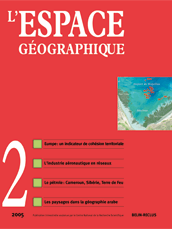

Towards the construction of a European indicator of territorial cohesion? (3 tabl., 5 fig., 1 annexe)
The development of a European index of territorial cohesion is both a scientific issue (exploration of possible solutions) and a political issue (potential use of the indicator to allocate aid to disadvantaged regions). This paper presents the first discussions on the issue within the framework of the ESPON 3.2 programme and emphasises the many traps raised by an attempt to construct such an index. A first review of existing work in the field of composite human development and sustainable development indices shows the extreme variety of possible solutions. A transposition of the HDI methodology to the European regional data in the second report on cohesion is proposed in order to assess its limitations and implications. The main innovation of the ESPON programme consists in taking the spatial dimension of the concept of territorial cohesion into account. This objective is illustrated by two exploratory studies: an attempt at an iterative redefinition of the Pentagon using territorial discriminant analysis; and a proposition of multivariate analysis of territorial discontinuities.
keywords: COMPOSITE INDEX, DISCONTINUITIES, DISCRIMINANT ANALYSIS, EUROPE, REGION, REGIONAL PLANNING, SPATIAL ANALYSIS, TERRITORIAL COHESION
Jean-Marc ZULIANI, Guy JALABERT. European aviation industry: industrial organisation and network operation (1 tabl., 3 fig.)
In recent years, the civil aviation industry has been experiencing a strong trend towards consolidation, resulting in the division of world production and medium and long-haul aircraft between European manufacturer Airbus and US manufacturer Boeing. The territorial organisation of the aviation industrial system shows the creation by these firms of a network company, based on the division of labour between several metropolises which each contain a complex of activities and interdependent know-how on their own scale, known as an extended company. For both Airbus on the scale of Europe, and Boeing on the scale of North America and the Pacific, network companies prevail through the exchange of personnel and information between several manufacturing locations, followed by a sophisticated system of logistics for transporting plane components to their final assembly locations.
keywords: AERONAUTICS INDUSTRY, AIRBUS, BOEING, COMPANY, GLOBALISATION, LOGISTICS
The dynamic of the international hinterland of Cameroons ports: impact of the Doba oil project at Kribi port (3 fig.)
Landlocked neighbouring countries of Cameroon, Chad and the Central African Republic (CAR), most of whose exports and imports transit via Douala, make a substantial contribution to the ports performance. This paper seeks to show that when the Doba oilfields in Chad start operating, the coastal site of Kribi, chosen to host the future oil terminal, will spur Cameroons pre-eminence in the handling of goods destined for the landlocked states in the Central African Economic and Monetary Community (CAEMC).
keywords: CAMEROON, CENTRAL AFRICAN REPUBLIC, CHAD, CONGO, OIL, PORT, TRANSPORT
The epic of hydrocarbon development in western Siberia, a fresh look at the core-periphery model (4 fig.)
Western Siberia is not often studied in geography. However it is extremely interesting as a full-scale laboratory of a case of spatial change in progress since its oil and gas resources have been developed. The region has made Russia one of the leading oil and gas producing countries and its economic function is now more industry-oriented. The territorial transition implies multi-temporal variations of spatial structures at regional, national and international scale. The core-periphery model is under challenge, but still shows strong resilience. Western Siberia, as a periphery, is becoming increasingly integrated. The spread of development is the main process occurring between the national core and western Siberia. Meanwhile, Siberia as a whole is less and less a homogeneous periphery. The backwash process dominates, and the gap between secondary cores and the rest of Siberia is widening.
keywords: ENERGY, RUSSIA, SPATIAL CHANGE, TERRITORIAL TRANSITION, WEST SIBERIA
New territorialities in Southern America. Energy activities and integration in the lands and seas of Magellan (3 fig., 4 photos)
The lands charted by Magellan exemplify emerging territorialities in Latin America. After a period of parallel, yet diverging evolutions, that can be related to the inclusion of these spaces in national territories, a new phase can be identified. It is strongly related to the connection of energy networks after 1990 and market reforms both in Argentina and Chile. Advanced by actors from the private sector and guided by new policies that are more mindful of the environment, the current trend gives a strong impetus to development. Spaces that were once separated by a border are now becoming complementary.
keywords: ARGENTINE, BORDER, CHILE, INTEGRATION, NETWORKS, OIL AND GAS, TIERRA DEL FUEGO
Representations of landscape in classical Arab geography from the eighth to the eleventh centuries. Landscapes methods and models
What is the link between classical Arab geography, religious views of nature, and landscape? This paper seeks to answer that question by showing that religion and secularism are not necessarily contradictory. At its beginnings, Arab geography was considered a rational, objective science with a rigorous method. The religion that inspired it was a motive for discovery, and landscape is nothing other than the leitmotiv and catalyst of profane and sacred social representations. We address the issue of geography, geographical methods and their links with religious precepts. The unity of the geographical corpus between the eighth and the eleventh centuries makes it possible to highlight the different levels of interpretation space and the landscape models that refer to space.
keywords: CLASSICAL ARAB GEOGRAPHY, LANDSCAPE, RELIGION, SECULARISM
Book reviews
In this issue of l’Espace géographique, you will find critical reviews of the following books
BUTTIMER Anne, editor (2001). Sustainable Landscapes and Lifeways: scale and appropriateness. Cork: Cork University Press, 398 p., ISBN 1 85918 300 X, (par Hugh CLOUT, University College London).
Lespace géographique 1/05![]()
![]() L’espace géographique 3/05
L’espace géographique 3/05
For subscribe or buy this issue: BELIN
![]() L’Espace géographique: contents
L’Espace géographique: contents
Last modified: May 19, 2005